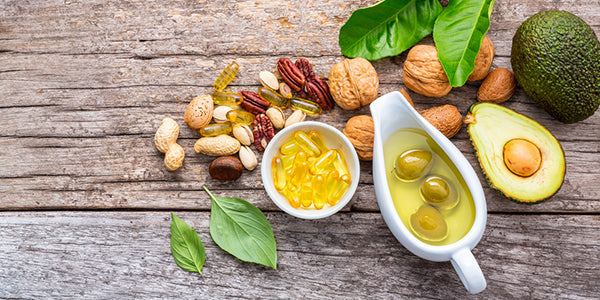
Low-fat diets were widely promoted in the past, as eating fat was thought to derail weight loss goals. Any fat in the diet was claimed to increase the risk of heart disease, too.
However, health experts now recognize fat is beneficial in the diet. But to maximize the health benefits, healthy fats should be the primary focus.
And whereas "healthy" and "fat" historically did not exactly coexist, you might be surprised to know what the pairing does together!
Dietary Fat 101
Dietary fat is one of the three macronutrients, with carbohydrate and protein being the other two.
Fat is considered calorically dense, supplying 9 calories per gram. Carb and protein, on the other hand, supplies 4 calories per gram.
Dietary fat is further broken down into trans, saturated, and unsaturated fats:
Trans Fats
Trans fats are also known as partially hydrogenated oils. They are created when unsaturated fats become saturated through the process of hydrogenation. They are largely found in stick margarine and the products they exist in, such as fried foods and baked goods.
Trans fats prove to negatively affect health. They increase LDL ("bad") cholesterol and lower HDL ("good") cholesterol, which in turn increases heart disease risk. Their intake has also been linked to type 2 diabetes development.
The American Heart Association (AHA) encourages to avoid or limit the intake of products containing trans fats.
Saturated Fats
Saturated fat is solid at room temperature and displays a high melting point. The fat is naturally found in animal and red meats, butter, and whole milk and full-fat dairy products. It is also found in plant-based sources such as coconut oil and butter and palm oils.
Saturated fat is not as discouraged as trans fats. However, the AHA recommends aiming for a dietary pattern that achieves five to six percent of calories from saturated fat.
Based on a 2,000-calorie diet, the recommended fat intake equates to more than 120 calories or 13 grams daily.
Unsaturated Fats
Unsaturated fats are broken down into monounsaturated (MUFAs) and polyunsaturated fatty acids (PUFAs):
• Monounsaturated fats: MUFAs are soft or liquid at room temperature and naturally-occur in plants. Plant-based sources include olive and canola oils, olives, nuts, nut butters, and avocados.
• Polyunsaturated fats: Like MUFAs, PUFAs are also soft or liquid at room temp. They are further broken down into omega-6 and omega-3 fatty acids. Among the two, omega-3 fatty acids are most encouraged related to their anti-inflammatory properties.
Omega-6 sources include vegetable oils and some meats. Omega-3s are widely recognized for being in fatty fish, including anchovy, tuna, herring, rainbow trout, and halibut. Flaxseeds, walnuts, pumpkin seeds, and olive oil are also sources of omega-3s.
Replacing saturated and trans fats with unsaturated fats can lower total cholesterol and LDL cholesterol in the blood. This, in turn, reduces the risk of developing heart disease.
Health experts also commonly suggest fat should comprise no more than 35 percent of total daily calories. Based on 2,000 calories, 35 percent totals to a max of 700 calories from fat per day. Or, close to 78 grams.
What Is the Function of Fats?
While cutting that so-called "bad fat" is essential to losing weight and overall health, what about healthy fat? Any good diet requires healthy fats and here are just a few reasons why:
Healthy Fat Helps Control Hunger and Cholesterol Levels
After we eat foods that contain fat, they linger in the stomach longer than both carbohydrate and protein. That being said, healthy fats help us feel fuller for longer bouts of time and control hunger levels.
Not only do these foods help control hunger, but the "good fats" are good for your cholesterol, heart, and overall health. "Bad fats" essentially only satisfy you for a little while and eventually increase the risk of heart disease.
Healthy Fat Promotes Healthy Metabolism
In addition to an adequate intake of protein and carbohydrates, your body needs fat in order to maintain a steady metabolism.
And unlike popular belief, healthy fats boosts metabolism to help rid the body of unwanted, excess body fat. Think of it this way: Without sufficient nutritious foods, including healthy fat, the body will essentially cannibalize off its lean mass for energy to burn fat mass. This is why a well-balanced diet is so essential when it comes to promoting a healthy and effective metabolism.
Healthy Fat Carries the Good Stuff
Other than helping your metabolism stay on track, healthy fat is one of your body’s best transporters. Fat molecules are actually responsible for transporting several nutrients throughout the body. These include the fat-soluble vitamins A, D, E, and K.
The fat-soluble vitamins are absolutely necessary for good health. In fact, inadequate intake of vitamin A, for example, can cause blindness and other problematic conditions. Without vitamin D, bones can become weak and brittle. And without vitamin E, you could experience changes in your blood and muscular problems.
Healthy Fat Protects Vital Organs
Other than promoting healthy metabolism and transporting essential vitamins, healthy fat also helps insulate and protect vital organs.
Even if having a smaller frame, most "thinner" people still have at least 10 percent body fat for these reasons. Fat serves as a cushion for organs and protects them from being harmed by any sort of trauma.
9 Tips for Adding More Healthy High-Fat Foods
Now after understanding the benefit of fat, you might be anxious to know how to include healthier options in the diet.
Fortunately, replacing unhealthy fats with healthy fats in the diet can be simple with these tips:
1. Check the Ingredient Label for Good Fats
Check food labels for trans fats, which may also be identified as partially hydrogenated oil, and other added fats and oils.
No ingredient label? Limiting commercially-baked goods and fast food naturally lowers the risk of unhealthy fat intake.
2. Include Healthy Fats to Grocery Lists
Rather than heading to the store on a whim, make a grocery list with healthy fats. Having this list is especially handy if heading to the store hungry.
Feeling ravenous heightens the risk of chips, cookies, and other convenience foods ending up in the cart. And, naturally and eventually, in the home.
3. Cook With Healthy Oils
Rather than cooking with margarine or butter, cook with heart-healthy oils, including canola and olive oils.
Use olive oil for non or low-heat cooking methods, including uncooked sauces and dips or roasted and sautéed veggies. Cook with canola oil at slightly higher temperatures.
4. Sneak Healthy Fats Into Meals
Along with cooking with oils, add heart-healthy fats seamlessly into meals.
For instance, add chia seeds into smoothies or breakfast muffins. When coating chicken, swap out standard breadcrumbs for ground flax seeds.
5. Add Healthy Fats to Salads
Salads are a blank canvas that can harness a plethora of healthy fats, including nuts, seeds, avocadoes, tuna, and soybeans.
With commercial salad dressings often containing unhealthy fat and/or added sugars, dress greens with olive, flaxseed, or sesame oils.
6. Snack on Healthy Fats
Resorting to convenience snacks amidst a hunger pang might satisfy you in the moment. But, they often only leave you feeling dissatisfied quickly after.
Trail mixes, olives, fuller fat yogurts, and nut butters help to induce satiety while lending heart-healthy fats. And to beat that sweet tooth, enjoy a piece of dark chocolate!
7. Try New Recipes
One of the best (and fun) ways to get more healthy fats in the diet is by trying new recipes. Besides, you never know which good fats you like without trying them!
There are numerous recipes embracing healthy fats, including blackened salmon paired with Cajun cauliflower florets and a creamy avocado ice cream!
8. Use a Meal Delivery Service
Using a meal delivery service can be solution to eating more healthy fats as well. In fact, bistroMD meals contain 1,100 to 1,400 calories daily with 40 to 50 percent of total calories from lean protein. Twenty to to 25 percent of calories come from healthy fats and 30 to 35 percent from complex carbohydrate.
Also offering 200 recipes and a customizable menu, there is sufficient variety to satisfy the nutrients your body needs and the flavors your taste buds crave! Meals include grilled salmon with creamy pesto and Moroccan beef and vegetables with quinoa!
9. Repeat These Steps
With repetition, including healthier fats into the diet will start to become a natural routine.
And with consistency, you can start reaping the health benefits of eating these good fats!








